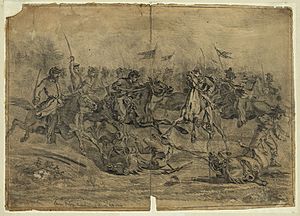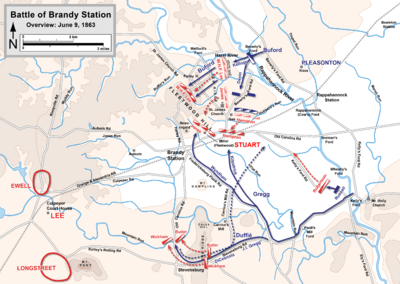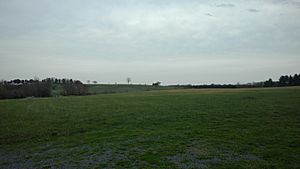Battle of Brandy Station facts for kids
Quick facts for kids Battle of Brandy Station |
|||||||
|---|---|---|---|---|---|---|---|
| Part of the American Civil War | |||||||
 "Cavalry Charge Near Brandy Station" by Edwin Forbes |
|||||||
|
|||||||
| Belligerents | |||||||
| Commanders and leaders | |||||||
| Alfred Pleasonton | J.E.B. Stuart | ||||||
| Units involved | |||||||
| Cavalry Corps, Army of the Potomac | Cavalry Division, Army of Northern Virginia | ||||||
| Strength | |||||||
| 11,000 | 9,500 | ||||||
| Casualties and losses | |||||||
| 1,007 total (69 killed 452 wounded 486 missing/captured) |
523 total (51 killed 250 wounded 132 missing/captured) |
||||||
The Battle of Brandy Station, also known as the Battle of Fleetwood Hill, was the biggest cavalry battle of the American Civil War. It was also the largest cavalry fight ever on American land. This battle happened on June 9, 1863, near Brandy Station, Virginia. It was the start of the famous Gettysburg Campaign.
In this battle, the Union cavalry, led by Alfred Pleasonton, launched a surprise attack. They fought against the Confederate cavalry, led by J.E.B. Stuart. The fight lasted all day, with both sides gaining and losing ground. In the end, the Union forces pulled back. They did not find Robert E. Lee's main army, which was camped nearby. This battle was important because it showed that Union cavalry was now as strong and skilled as the Confederate cavalry.
Contents
Why the Battle Happened
Confederate Army Moves North
In May 1863, the Confederate Army of Northern Virginia moved into Culpeper County, Virginia. This happened after their victory at the Battle of Chancellorsville. Under General Robert E. Lee, the troops gathered near Culpeper. They were getting ready to move north into Pennsylvania.
Lee's army needed supplies like food, horses, and equipment. He hoped to get these by moving north. His army could also threaten major cities like Philadelphia, Baltimore, and Washington, D.C.. This might encourage people in the North who wanted peace.
Stuart's Cavalry Screens the Army
By June 5, two large groups of Confederate infantry were camped near Culpeper. Six miles northeast, General Stuart's cavalry was camped along the Rappahannock River. Their job was to protect the main Confederate army from being surprised by the enemy.
Most of Stuart's cavalry was near Brandy Station. Stuart was known for being a "dashing cavalier." He asked General Lee to review his troops. This big review happened on June 5. Nearly 9,000 mounted troopers and 4 artillery units took part. They even did a pretend battle.
General Lee could not attend the first review. So, it was repeated on June 8, but it was just a simple parade. Some soldiers and reporters complained that Stuart was just showing off. They felt he was tiring out the horses for no good reason. Lee then ordered Stuart to cross the Rappahannock River the next day. Stuart was to raid Union positions and keep the Confederate army hidden as it moved north. Stuart sent his tired troopers back to camp near Brandy Station.
Who Fought and Pleasonton's Plan
Confederate Forces
General Stuart's force had about 9,500 men. It included five cavalry brigades. These were led by generals like Wade Hampton III and William Henry Fitzhugh Lee. There was also a six-battery artillery unit.
Union Forces and Their Plan
The Confederates did not know that 11,000 Union soldiers were gathered across the Rappahannock River. Major General Alfred Pleasonton led the Union cavalry. He divided his forces into two main groups. These were led by John Buford and David McMurtrie Gregg. They also had infantry soldiers helping them.
The Union commander, Joseph Hooker, thought the Confederate cavalry was planning to attack his supply lines. So, he ordered Pleasonton to launch a "spoiling raid." This meant he should attack first to disrupt the Confederates. Pleasonton planned a two-part attack. Buford's group would cross the river at Beverly's Ford. At the same time, Gregg's group would cross at Kelly's Ford, further downstream. Pleasonton hoped to trap the Southern cavalry in a "double envelopment," meaning they would be attacked from two sides. He thought his force was much larger than the Confederates, but he was wrong about their exact positions.
The Battle Unfolds
Surprise at Beverly's Ford
Around 4:30 a.m. on June 9, Buford's group crossed the Rappahannock River. It was very foggy. They easily pushed past the Confederate guards at Beverly's Ford. This was the first big surprise for the Confederates that day.
Jones's Confederate brigade woke up to the sound of gunfire. They quickly rode to the scene, some still half-dressed. They attacked Buford's lead brigade, stopping their advance. The Union commander, Colonel Benjamin Franklin Davis, was killed. Buford's men were stopped just before they reached Stuart's Horse Artillery camp. The artillery quickly got some guns ready and fired, allowing the other cannons to escape.
The Confederate artillery set up on two small hills. Most of Jones's men gathered on the left side of this artillery line. Hampton's brigade formed on the right. The 6th Pennsylvania Cavalry charged the Confederate guns at St. James Church. They suffered the most losses of any regiment in the battle. Many Confederates later called this charge the most "brilliant and glorious" cavalry charge of the war. In this battle, cavalry often fought while still on horseback, which was unusual for the time.
Gregg's Attack on Fleetwood Hill
Buford tried to go around the Confederate left side to get to the artillery. But Rooney Lee's brigade blocked him. After heavy fighting, the Union soldiers pushed the Confederates back from a stone wall. Then, Buford's men were surprised when the Confederates started to pull back.
The Confederates were reacting to the arrival of Gregg's Union cavalry division. This was the second big surprise of the day. Gregg had planned to cross at Kelly's Ford at dawn, at the same time as Buford. But getting his men together and one division getting lost caused a two-hour delay. Gregg found an unguarded path and arrived in Brandy Station around 11 a.m.
Between Gregg's position and the St. James battle was a hill called Fleetwood Hill. This had been Stuart's headquarters the night before. Stuart and most of his staff had already left for the front. Only a single cannon was on Fleetwood Hill when Gregg arrived. Stuart's assistant, Major Henry Brainerd McClellan, quickly called for the cannon to fire. He also sent an urgent request for Stuart to send help. The few shots from the cannon delayed the Union advance.
When Gregg's men charged up Fleetwood Hill, they met Jones's brigade, which had just pulled back from St. James Church. Gregg's next brigade, led by Colonel Hugh Judson Kilpatrick, attacked the eastern side of Fleetwood Hill. But Hampton's brigade arrived at the same time. There were many confusing charges and countercharges across the hill. The Confederates finally cleared the hill, capturing three cannons.
End of the Battle
While Jones and Hampton fought at Fleetwood Hill, Rooney Lee continued to fight Buford. Rooney Lee fell back to the northern end of Fleetwood Hill. He was joined by Fitzhugh Lee's brigade. Rooney Lee then launched a counterattack against Buford. At the same time, Pleasonton ordered a general retreat as the sun began to set. The ten-hour battle was over.
What Happened After the Battle
[Brandy Station] made the Federal cavalry. Up to that time confessedly inferior to the Southern horsemen, they gained on this day that confidence in themselves and in their commanders which enable them to contest so fiercely the subsequent battle-fields ...
The Union army had 907 casualties (soldiers killed, wounded, or captured). The Confederates had 523 casualties. About 20,500 men fought in this battle. General Robert E. Lee's son, Rooney, was seriously wounded. He was later captured on June 26.
Stuart said the battle was a Confederate victory. He argued that his side held the battlefield at the end of the day and stopped Pleasonton's attack. However, Southern newspapers were mostly negative. They felt Stuart had not done well.
Some Union officers criticized Pleasonton. They felt he should have defeated Stuart more aggressively. Pleasonton said he was only ordered to "reconnaissance in force," meaning to scout out the enemy's strength, not to destroy them.
For the first time in the Civil War, Union cavalry showed they were as skilled and determined as the Confederate horsemen. Stuart being surprised twice in this battle was a sign of more troubles to come for him in the Gettysburg campaign.
Saving the Battlefield
The Brandy Station Foundation (BSF) was created to protect the Brandy Station Battlefield from being developed. This group started with a few citizens and grew to over 400 members. They have worked hard to save the battlefield from plans to build an office park or a racetrack. They also helped preserve the historic building called Graffiti House. In 1990, the National Park Service suggested preserving 1,262 acres of the battlefield.
The American Battlefield Trust has been a major group helping to save Brandy Station. This Trust, with help from the BSF, has bought and protected over 2,159 acres of the battlefield since 1997. In 2003, this led to the opening of Brandy Station Battlefield Park. This park helps people learn about the history of the site. This work has stopped many businesses from building on the battleground. In 2013, the Trust bought 61 acres at Fleetwood Hill, where many cavalry charges happened during the battle.
In 2022, Virginia agreed to take over 1,700 acres from the Trust. They also plan to buy up to 800 more acres to create the Culpeper Battlefields State Park. This park is set to open on July 1, 2024.



